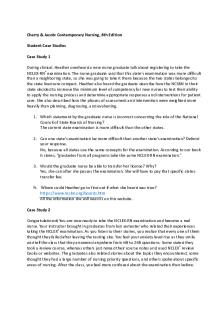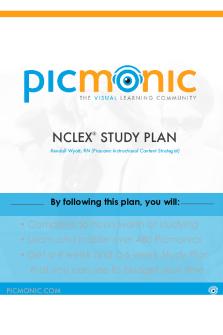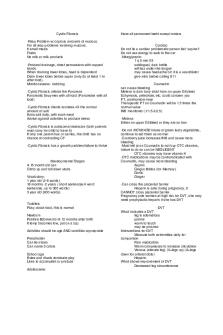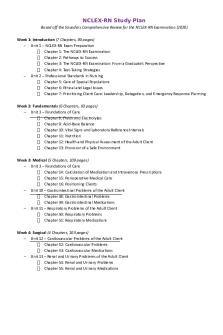Angie s Nclex study packet PDF

| Title | Angie s Nclex study packet |
|---|---|
| Author | ashlyn clark |
| Course | Nursing Health Assessment |
| Institution | University of South Carolina |
| Pages | 125 |
| File Size | 3.2 MB |
| File Type | |
| Total Downloads | 389 |
| Total Views | 538 |
Summary
Congratulations on passing nursing school! this was a huge accomplishment in itself. I want you to know how proud we are of you and we believe in you! first things first , let's talk about study habits and how to prepare for NCLEX RN/ PNThe 21 day NCLEX preparation guide 21 days is roughly 3 weeks. ...
Description
Congratulations on passing nursing school! this was a huge accomplishment in itself. I want you to know how proud we are of you and we believe in you ! first things first , let's talk about study habits and how to prepare for NCLEX RN/ PN The 21 day NCLEX preparation guide 21 days is roughly 3 weeks. in those three weeks you’ll be anxious and nervous so lets get a plan! week 1 : learn the WWW question breakdown method ( outlined at the end of the study guide) practice 75 questions each day and WRITE THE RATIONALES to the ones you missed in a binder. take a small break each day to do something you love. go back over the rationales of the day at least 5 times. Also any material you aren't grasping go back to Mike’s simple nursing videos. www.simplenursing.com Week 2: getting closer right? Time to teach! every opportunity you get teach a concept to someone, when you're ready to study we're going to repeat week 1 ( wine at this time is ok lol) or men go shoot some guns or fish before sitting down to studying. practice 75 questions each day and WRITE THE RATIONALES to the ones you missed in a binder. take a small break each day to do something you love. go back over the rationales of the day at least 5 times. Week 3 : The final countdown! please I beg you to relax that week! teach when you can and we're going to cut back on study time with a final power push 48 hours before. M-W only do about 25 questions with rationales WRITE THE RATIONALES to the ones you missed in a binder. take a small break each day to do something you love. go back over the rationales of the day at least 5 times. NOW 48 hours before the exam were going to do an nclex power push with questions do as many as possible BUT before you write the rationales they give you write your own rationales and see where you compare and adjust as needed. Get a map of there you are taking your test and drive there in traffic so you can see how long it's going to take to get there so you aren't late.
Night before the EXAM : stop studying at 830, have a good meal , and sleep! Morning of the EXAM : Eat breakfast, get ready and be comfortable, if you are used to lounge clothes wear that . if you're superhuman and used to looking killer when you're in public this would be a good day to kill it too. GOOD LUCK!
The services and all information, products, and other content included in this guide or other materials accessible from the services are provided "as is" and without warranties of any kind (express, implied, and statutory, including but not limited to the implied warranties of merchantability and fitness for a particular purpose), all of which Angie Renee expressly disclaim to the fullest extent permitted by law." This is not medical advice and should under no circumstances be used as such.
● Focus on your successes encouraging yourself to greater achievements in the future and Forget your past mistakes. ● Always do your best so you can be proud that you gave it your best shot. ● Focus on your achievements rather than your failures. If you do find yourself thinking about how you failed then look at what you managed to do right and how you could correct what you did next time. ● A mind that is troubled with doubt won't be able to focus on the victory to be had. ● Take time for yourself. A fried mind can't focus or learn. ● Look carefully when you have no idea. In a word like rhabdomyosarcoma you can easily ascertain it has something to do with muscle (myo) cancer (sarcoma). The same thing goes for drug names. For example, if it ends in –ide it’s probably a diuretic, as in Furosemide, and Amiloride. ● When getting down to two answers, choose the assessment answer (assess, collect, auscultation, monitor, palpate) over the intervention except in an emergency or distress situation. If one answer has an absolute, discard it. Give priority to answers that deal directly to the patient’s body, not the machines/equipments. ● Key words are very important. Avoid answers with absolutes for example: always, never, must, etc. ● When choosing an answer, think in this manner… if you can only do ONLY one thing to help this patient what would it be? Pick the most important intervention. ● If two of the answers are the exact opposite, like bradycardia or tachycardia... one is probably the answer. ● If two or three answers are similar or are alike, none is correct. ● When asking patients’ questions NEVER use “why” questions. Eliminate all “why?” answer options. ● If you have never heard of it… please don’t pick it! ● Never release traction UNLESS you have an order from the MD to do so ● Always deal with actual problems or harm before potential problems ● Always select a “patient focused” answer. ● An answer option that states "reassess in 15 minutes" is probably wrong.
● An answer that delays care or treatment is ALWAYS wrong DO NOT delegate what you can EAT! or PACET P – Planning A – Assess (Primary/Initial) C – Collaboration (with RT, OT, PT, ETC) E – Evaluate (for trends) 1. – Teach ○ Assessment, teaching, i.v. meds, evaluation, unstable patient cannot be delegated to an Unlicensed Assistive Personnel. ○ LVN/LPN cannot handle blood. Vit K is to coumadin as Protamine Sulfate is to Heparin as Ca Glu is to MgSo4 as Mucomyst is to Acetaminophen as Amicar is to TPA…get it? Antidotes/treatments for overdose -
REVERSE AGENTS FOR TOXICITY
ammonia= lactulose acetaminophen= n-Acetylcysteine. Iron= deferoxamine, Digitoxin/digoxin= digibind. Alcohol withdrawal= Librium. ● methadone is an opioid analgesic used to detoxify/treat pain in narcotic addicts. ● Potassium potentiates dig toxicity.
Order of assessment: Inspection, Palpation, Percussion and Auscultation. EXCEPT with abdomen cuz you don’t wanna mess with the bowels and their sounds so you Inspect, Auscultate, Percuss and Palpate (same with kids, I suppose since you wanna go from least invasive to most invasive since they will cry! Gotta love them kids!) No Pee, no K (do not give potassium without adequate urine output) EleVate Veins; dAngle Arteries for better perfusion For PVD remember DAVE (Legs are Dependent for Arterial & for Venous Elevated) Arterial – PPP, Pain, pallor, pulselessness. Stand up to reduce pain
G= grimace {reflex irritability} (cough/pulls away ↘ facial movement/grimace only with stimulation ↘ no response) A= activity {muscle tone} (spontaneous activity ↘ arms/legs flexed with little movement ↘ limp/floppy tone) R= respirations {effort} (30-60 bpm/strong cry ↘ irregular/slow breathing/weak cry ↘ absent) TRANSMISSION-BASED PRECAUTIONS: AIRBORNE - Private Room - negative pressure with 6-12 air exchanges/hr, Mask, N95 for TB My - Measles or remember... MTV=Airborne
Chicken - Chickenpox/Varicella
Measles
Hez - Herpes Zoster/Shingles TB Shingles
TB Varicella-Chicken Pox/Herpes Zoster-
DROPLET - Private Room or cohort Mask think of SPIDERMAN! S – sepsis, S - scarlet fever, Streptococcal pharyngitis P - parvovirus B19, P - pneumoniae P - pertussis I - influenza D - diphtheria (pharyngeal) E - epiglottitis R - rubella M – mumps, Meningitis, M - mycoplasma or meningeal pneumonia An - Adenovirus CONTACT PRECAUTION MRS.WEE M - multidrug resistant organism W - wound infxn R - respiratory infection E - enteric infxn - clostridium difficile S - skin infections * E - eye infxn - conjunctivitis SKIN INFECTIONS VCHIPS V - varicella zoster C - cutaneous diphtheria H - herpes simplex I - impetigo P - pediculosis S - scabies 1.
Air/Pulmonary Embolism (S&S: chest pain, difficulty breathing, tachycardia, pale/cyanotic, sense of impending doom) → turn pt to left side and lower the head of the bed. 1. Woman in Labor w/ Non-reassuring FHR (late decels, decreased variability, fetal bradycardia, etc) → turn on left side (and give O2, stop Pitocin, increase IV fluids) 1. Tube Feeding w/ Decreased LOC → position pt on right side (promotes emptying of the stomach) with the HOB elevated (to prevent aspiration) 1. During Epidural Puncture → side-lying 2. After Lumbar Puncture (and also oil-based Myelogram)→ pt lies in flat supine (to prevent headache and leaking of CSF). AFTER the procedure, the client should be placed in the supine position for 4 to 12 hrs as prescribed. (Saunders 3rd ed p. 229) 1. Pt w/ Heat Stroke → lie flat w/ legs elevated 1. During Continuous Bladder Irrigation (CBI) → catheter is taped to thigh so leg should be kept straight. No other positioning restrictions. 1. After Myringotomy → position on side of affected ear after surgery (allows drainage of secretions) 1. After Cataract Surgery → pt will sleep on unaffected side with a night shield for 1-4 weeks. 1. After Thyroidectomy → low or semi-Fowler's, support head, neck and shoulders. 1. Infant w/ Spina Bifida → position prone (on abdomen) so that sac does not rupture 1. Buck's Traction (skin traction) → elevate foot of bed for counter-traction 1. After Total Hip Replacement → don't sleep on operated side, don't flex hip more than 45-60 degrees, don't elevate HOB > 45 degrees. Maintain hip abduction by separating thighs with pillows. 1. Prolapsed Cord → knee-chest position or Trendelenburg 1. Infant with/ Cleft Lip → position on back or in infant seat to prevent trauma to suture line. While feeding, hold in upright position.
1. To Prevent Dumping Syndrome (post-operative ulcer/stomach surgeries) → eat in reclining position, lie down after meals for 20-30 minutes (also restrict fluids during meals, low CHO and fiber diet, small frequent meals) and increase fat and protein, wait 1 hr after meals to drink. Unusual positional tip - Low-fowler's recommended during meals to prevent dumping syndrome. 1. Above Knee Amputation → elevate for first 24 hours on pillow, position prone daily to provide for hip extension. 1. Below Knee Amputation → foot of bed elevated for first 24 hours, position prone daily to provide for hip extension. 1. Detached Retina → area of detachment should be in the dependent position 1. Administration of Enema → position pt in left side-lying (Sim's) with knee flexed 1. After Supratentorial Surgery (incision behind hairline) → elevate HOB 30-45 degrees 1. After Infratentorial Surgery (incision at nape of neck) → position pt flat and lateral on either side. 1. During Internal Radiation → on bedrest while implant in place, treat pt as they are radioactive. Tongs 1. Autonomic Dysreflexia/Hyperreflexia (S&S: pounding headache, profuse sweating, nasal congestion, goose flesh, bradycardia, hypertension) → place client in sitting position (elevate HOB) first before any other implementation. 1. Shock → bedrest with extremities elevated 20 degrees, knees straight, head slightly elevated (modified Trendelenburg) 1. Head Injury → elevate HOB 30 degrees to decrease intracranial pressure 1. Peritoneal Dialysis when Outflow is Inadequate → turn pt from side to side BEFORE checking for kinks in tubing (according to Kaplan) Demerol for pancreatitis, NOT morphine sulfate. 1. Morphine is contraindicated in Pancreatitis. It causes spasm of the Sphincter of Oddi. Therefore Demerol should be given. Myasthenia Gravis: worsens with exercise and improves with rest caused by a disorder in the transmission of impulses from nerve to muscle cell (does not affect the bladder & bowel). *Tensilon test given if muscle is tense in myasthenia gravis. Myasthenia Crisis: a positive reaction to Tensilon--will improve symptoms and confirms the diagnosis Cholinergic Crisis: caused by excessive medication-stop med-giving Tensilon will make it worse DUMBBELLS A G: Defecation, Urination, Miosis, Bradycardia, Emesis, Lacrimation, Lethargy, Salivation, Abdominal cramps G.I. upset
Give neostigmine to clients with Myasthenia Gravis about 45 min. before eating, so it will help with chewing and swallowing. Head injury medication: Mannitol (osmotic diuretic)-crystallizes at room temp so ALWAYS use filter needle Prior to a liver biopsy it’s important to be aware of the lab result for prothrombin time From the a$$ (diarrhea) = metabolic acidosis
From the mouth (vomitus) = metabolic alkalosis
Thyroid – TSH test will differentiate between primary and secondary Thyroid scan – no seafood, meds, or cough meds 7-10 days prior. Myxedema/hypothyroidism: slowed physical and mental function, fatter, sensitivity to cold, dry skin and hair. ↓ BMI. Give meds and correct hypothermia warming blanket). * Anti-HTN and thyroid meds in the A.M. otherwise INSOMNIA. Synthroid: TX of hypothyroidism..may take several weeks to take effect...notify doctor of chest pain..take in the AM on empty stomach..could cause hyperthyroidism. HYPERthyroidism think of MICHAEL JACKSON in THRILLER! Skinny, Nervous, Bulging Eyes, Up all night, heart beating fast Graves’ disease/hyperthyroidism: accelerated physical and mental function; sensitivity to heat, fine/soft hair, Goiter, Bulging eyes. Eating +++ but still thin. When giving meds watch for hypothyroidism. Thyroid storm: increased temp, HR and HTN d/t: Surgery (Physical movement of thyroid), infection, stress Post-thyroidectomy: semi-Fowler’s, prevent neck flexion/hyperextension, trach at bedside, freq swallowing is bad Esophageal variceal – bleeding results in abdominal distention not swallowing Sengstaken blakemore tube used for TX of esophageal varices, keep scissors at bedside in case of shock. Insomnia is a side effect of thyroid hormones. Increased met. rate, your body is "too busy to sleep" as opposed to the folks with hypothyroidism who may report somnolence (↓ met rate, body is slow and sleepy). Burning sensation in the mouth, and brassy taste are adverse reactions to Lugol solution (for hyperthyroid). Report it to the doc. Give synthroid on an empty stomach PTU and Tapazole- prevention of thyroid storm Hypovolemia – increased temp, rapid/weak pulse, increase respiration, hypotension, anxiety, urine specific gravity >1.030 Hypervolemia – bounding pulse, SOB, dyspnea, rales/crackles, peripheral edema, HTN, urine specific gravity 6 is good to induce since cervix is ripe and induction may be successful. ● best way to warm a newborn: skin to skin contact covered with a blanket on mom. ● when a pt comes in and she is in active labor...nurse first action is to listen to fetal heart tone/rate Ventilator alarms – When in doubt BAG! HOLD High alarm- Obstruction due to↑ secretions, kink, pt. coughs, gag or bites
Low press alarmbreathing
Disconnection/leak in ventilator or in pt. airway cuff, pt. stops spontaneous
Blood sugar: Hot and Dry-sugar High (hyperglycemia) Cold and Clammy-need some Candy (hypoglycemia) 1. ICP AND SHOCK HAVE OPPOSITE V/S ICP- ↑ BP, ↓ pulse, ↓ resp. SHOCK↓ BP, ↑ pulse, ↑ resp. 1. cor pulmonale: right sided heart failure caused by left ventricular failure (so pick edema, jvd, if it is a choice.) 1. heroin withdrawal neonate: irritable and poor sucking 1. Muslims: allow time for prayer & fasting in Ramadan. Jews: no meat & milk together. No blood for Jehovah Witness
1. Brachial pulse: check pulse area cpr on an infant. BP cuff cover 75% of arm and 2 cm above ac. 1. Test child for lead poisoning (plumbism) around 12 months. * remove environmental source, start chelation therapy Lead poisoning: ABCDEFG: Anemia, Basophilic stippling, Colicky pain, Diarrhea, Encephalopathy, Foot drop, Gum (lead line) 1. Cultures are obtained before starting IV antibiotics ALWAYS to see sensitiveness. 1. Phobic disorders...use systematic desensitization. 1. With lower amputations patient is placed in prone position but elevate for first 24 hours. 1. Small frequent feedings are better than larger ones. 1. Aminoglycosides (like vancomycin) cause nephrotoxicity and ototoxicity. 1. IV push should go over at least 2 minutes. Never push K+ 2. If the patient is not a child an answer with family option can be ruled out easily. 3. In an emergency/crisis, patients with greater chance to live are treated first, so they can help others. 1. ARDS (fluids in alveoli), DIC (disseminated intravascular coagulation) are always secondary to something else (another disease process). 2. Cardinal sign of ARDS is hypoxemia (low oxygen level in tissues). 1. In pH regulation the 2 organs of concern are lungs/kidneys. Resp Opposite, Metabolic Equal, red for acidic, blue for alkaline pH 7.35-7.45 | pCO2 >45 -...
Similar Free PDFs

Angie s Nclex study packet
- 125 Pages

Angie s Nclex study packet
- 117 Pages

Angie
- 10 Pages

Nclex Study PLAN
- 3 Pages

New Nclex Study Plan
- 8 Pages

Nclex Case Study (prep)
- 3 Pages

Picmonic Nclex Study Plan
- 38 Pages

Nclex study plan
- 38 Pages

NCLEX STUDY DOCUMENT
- 16 Pages

Maternity Nclex Study Guide
- 10 Pages

Nclex study guide pdf
- 42 Pages

nclex study guide Kaplan
- 15 Pages

Nclex Study Plan - NAsda
- 3 Pages

Nclex Review - study guide
- 84 Pages

Nclex Study Guide Leslie
- 56 Pages
Popular Institutions
- Tinajero National High School - Annex
- Politeknik Caltex Riau
- Yokohama City University
- SGT University
- University of Al-Qadisiyah
- Divine Word College of Vigan
- Techniek College Rotterdam
- Universidade de Santiago
- Universiti Teknologi MARA Cawangan Johor Kampus Pasir Gudang
- Poltekkes Kemenkes Yogyakarta
- Baguio City National High School
- Colegio san marcos
- preparatoria uno
- Centro de Bachillerato Tecnológico Industrial y de Servicios No. 107
- Dalian Maritime University
- Quang Trung Secondary School
- Colegio Tecnológico en Informática
- Corporación Regional de Educación Superior
- Grupo CEDVA
- Dar Al Uloom University
- Centro de Estudios Preuniversitarios de la Universidad Nacional de Ingeniería
- 上智大学
- Aakash International School, Nuna Majara
- San Felipe Neri Catholic School
- Kang Chiao International School - New Taipei City
- Misamis Occidental National High School
- Institución Educativa Escuela Normal Juan Ladrilleros
- Kolehiyo ng Pantukan
- Batanes State College
- Instituto Continental
- Sekolah Menengah Kejuruan Kesehatan Kaltara (Tarakan)
- Colegio de La Inmaculada Concepcion - Cebu
